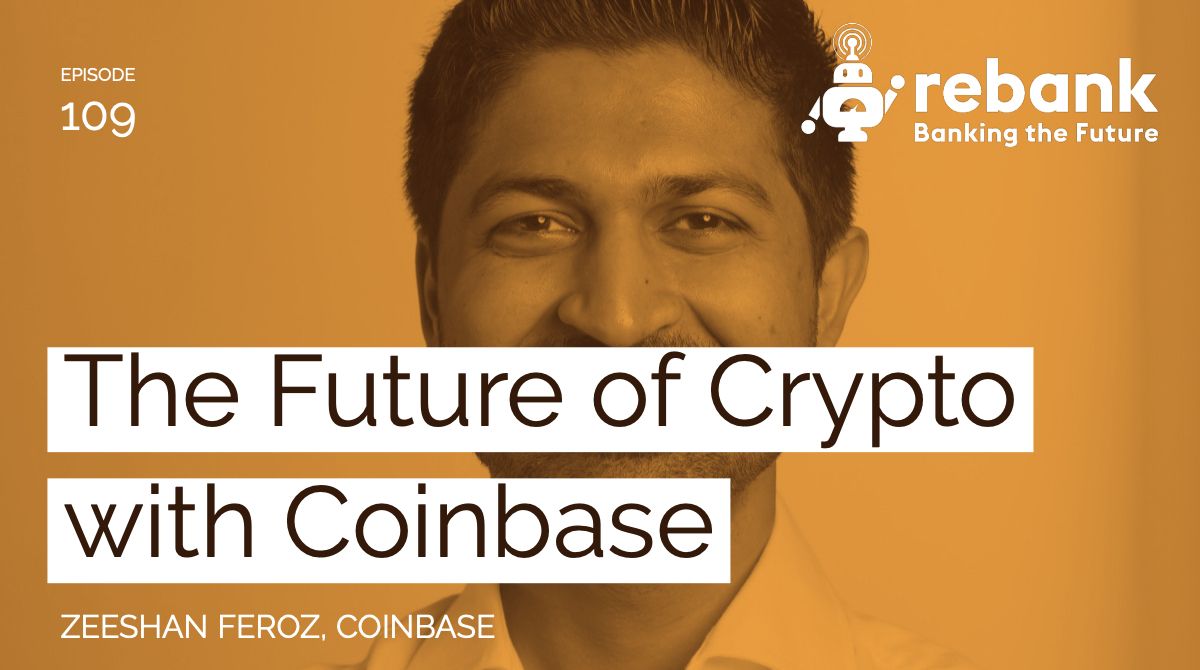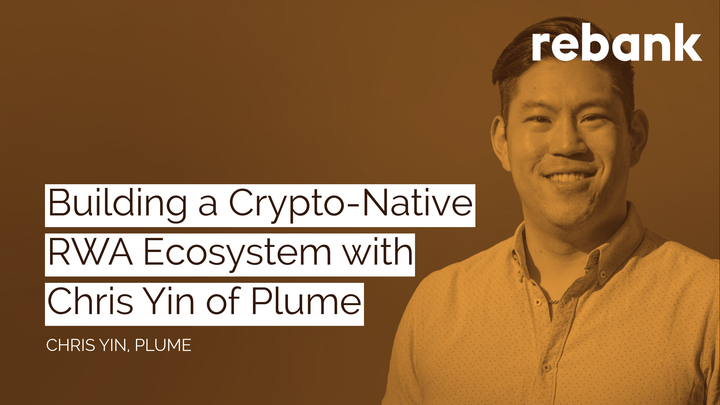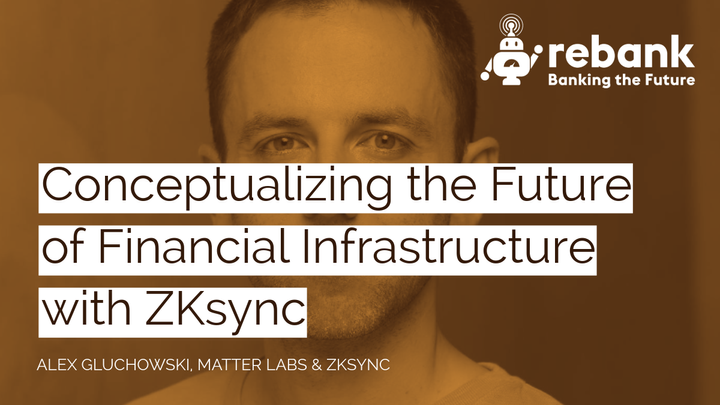The Future of Crypto with Coinbase

Today, we're joined by Zeeshan Feroz, UK CEO of Coinbase, the world's leading consumer crypto company.
In this conversation, we discuss Coinbase's recent progress and future plans, the current state of the crypto industry and what the lasting impact of this wave of crypto innovation will be.
As always, connect with us on Twitter, Facebook, LinkedIn or on our website at rebank.cc.
Thank you very much for joining us today. Please welcome, Zeeshan Feroz.
Will:
It's great to connect with you — and here we are in London. So, Coinbase: originally the crypto wallet to end all crypto wallets. I'm sure you'll explain how far it's come since then and the work you’ve done over the past few years. It’s a US company, but you've built a pretty significant presence here in London.
Tell me about your role and Coinbase’s footprint here in the UK.
Zeeshan:
Europe is now one of our fastest-growing markets and the largest outside the US. A couple of years ago, we made a deliberate decision to enter Europe and extend our products to this market.
It’s been an incredible journey over the last two years. We’ve grown from a small, one-person office to the team we have today. London serves as our European hub — it’s our headquarters here, and it also functions as an engineering center. In fact, it’s our only significant engineering presence outside San Francisco.
What motivated that? London is an ideal melting pot of financial services and tech talent — exactly what we needed. And it offers the right regulatory environment to start and build a crypto business.
Will:
You said you've grown from two employees when you first set up here to something like 50 now?
Zeeshan:
We’re definitely growing very quickly. Honestly, if you asked me how many employees we had last week, the number would be different from today. We’ve got new people joining every week.
Will:
Excellent. So, just to set the scene — catch us up on the state of crypto. On the podcast, we connect with crypto specialists from time to time — good friend Lex Lin, B2C2, Circle — and given how fast-moving the space is, it's always worthwhile to start with a bit of an overview.
What’s happened over the past month or two? What are people focused on? What's the current pulse of the space?
Zeeshan:
There’s never a dull moment in crypto, is there? There’s been a huge amount of news recently, especially on the regulatory front.
From our perspective, we’ve stayed focused on what we believe is the real potential of crypto — building an ecosystem and a new financial system that goes beyond just investment. We’re looking at driving real utility and real-world use cases.
The theme we’re seeing — and continue to see — is the emergence of exciting, meaningful products. Real projects with real promise that, we hope, will continue to drive user adoption going forward. That’s what we’re focused on, and it’s becoming more visible in the space.
Will:
Right. So, as we get into things, it might be helpful for context if you could share some key Coinbase metrics — maybe around capital raised, customer numbers, transaction volumes. How do you describe the scale of what you've built?
Zeeshan:
That’s a good question. One thing that always fascinates me — and we actually published a blog post on this just a few days ago — is how much Coinbase has evolved in terms of the verticals we now operate in.
If you rewind three years, Coinbase was a consumer-facing wallet. That naturally created a need for us to build an exchange, given the buy and sell pressure from users. So, we launched one.
Today, the Coinbase brand spans over ten different business lines — from our consumer products like Coinbase Consumer and Coinbase Wallet, to our merchant solution, Coinbase Commerce, and all the way to institutional offerings.
On that end, we’ve built custody services, evolved our exchange into Coinbase Pro and Coinbase Prime, launched an index fund, and grown our ventures arm, which has made over 15 investments in just the past few months.
What’s most interesting is how the business has grown to fill gaps and seize opportunities across the market — all within the last 12 months.
On the consumer side, which is still where the brand began and remains strongest, we now serve over 20 million clients. From a European perspective, the EU has actually grown twice as fast as the US for us in terms of user acquisition and platform activity. Engagement from European customers has far outpaced what we’re seeing stateside.
Will:
Over what time period?
Zeeshan:
Last year.
Will:
Hmm.
Zeeshan:
It’s funny — around this time last year, as the market was rallying quite strongly, we were just trying to keep up with the influx of users signing up daily.
Our operations weren’t designed to handle that kind of scale, so scaling up has definitely been the most interesting — and challenging — thing we've done this year.
Will:
Do you see this as part of the natural hype cycle? You know — the initial boom, euphoria, consumers chasing speculative returns… then a sell-off, waning interest. But the people who are really serious about this space are the ones retrenching and building infrastructure that’ll support the industry for decades.
Is that where you think we are?
Zeeshan:
That’s exactly right. I think a lot of the people who came into the space last year were driven by investment potential. The market was certainly in a hype cycle.
But the silver lining is that many of those people bought their first coins. They took the first — and often hardest — step, which is getting over the mental hurdle of not knowing what crypto is or how to buy it.
Financial incentives pushed them to acquire crypto, however they did it. And now, they’re familiar with it.
Just on our platform, we have millions of users who now hold some crypto. So the next question becomes: what else can you do with it?
How do we move beyond just financial upside? How do we enable crypto as a means of payment, a store of value, a tool for remittance?
Those use cases are what I find truly exciting as we look ahead.
Will:
So, as you explained to me before we started recording, you're a trained cryptographer — having studied complex computer science topics and, no doubt, a fair amount of math.
Coinbase became hugely popular during the 2017 crypto boom, largely because it offered an easy, low-friction way for average retail customers to buy and sell major cryptocurrencies.
On the more extreme end of the crypto community, though, there was a sense that Coinbase didn’t fully deliver on the original promise of crypto — particularly around maximum security and decentralization. That ideal is centered on users holding their own private keys and storing tokens in cold storage, giving them complete control.
But for the average person, that’s a massive barrier to entry — as you mentioned earlier.
Now, pulling a few threads together here: you're working on Coinbase’s custody offering, and one of the historical barriers for institutional players entering the crypto space has been the lack of solid infrastructure for safeguarding digital assets.
How do you, as both a cryptographer and someone deeply experienced in this space, think about the trade-off between security, privacy, and functionality? Or maybe it's not even a trade-off — maybe there’s an optimal solution that’s still being developed?
Zeeshan:
I think you're right — it’s about finding a middle ground. And that middle ground depends on the specific use cases people want to pursue within the crypto ecosystem.
It comes down to a balance between centralization — where a trusted entity manages things — and full self-custody, where users hold and secure their own keys.
The original promise of crypto was exactly that: individual control. You hold your own keys. No intermediaries. That’s where the power of the technology lies — putting control back into the hands of users.
That promise still holds, and it's foundational to crypto. But what’s evolving is a second layer of services built on top of that foundation — services that bring usability and accessibility to a broader audience.
And yes, that shift involves trade-offs. Coinbase, for example, holds users' keys. That makes the platform more user-friendly — if you forget your password, you can reset it. Compare that to full self-custody: if you lose your private key, your funds are gone forever.
So there’s a spectrum. Some people will prefer the simplicity and safety net of centralized services. Others will opt for full control and take on the responsibility that comes with it.
What’s important is that in crypto, you have that choice. That’s the key difference from the traditional financial system — where such flexibility simply doesn’t exist.
Will:
What types of second-layer services do you expect to be built on top of the foundational crypto infrastructure?
Zeeshan:
I think the financial system will almost reinvent itself on crypto. You’re essentially looking at the last 200 years of financial evolution being rebuilt from the ground up on this new technology.
Some services will operate close to the base layer — where users interact directly with the chains. Others will be delivered through third parties like us.
Everything from institutional-grade custody solutions to consumer-friendly wallets — where keys are managed on behalf of users — are great examples.
One product we’re particularly excited about is Coinbase Commerce. It’s a good illustration of what’s possible at this second layer.
What we’ve done is build a tool that enables users to spend crypto directly from wallets they control, at merchant sites. Coinbase isn’t involved in the transaction itself — we don’t control the funds or process the payment.
Will:
So, kind of like merchant acquiring for crypto?
Zeeshan:
Exactly. It's a tool developed by a centralized company — Coinbase — but it empowers the user and the merchant to transact directly. We simply facilitate the acceptance by providing the infrastructure.
Will:
So, effectively, we're talking about analogs of traditional financial products and services — but built on crypto.
This leads us to a broader question: what is the future of the token, or cryptocurrency as a concept?
Is it an infrastructure play, where blockchain replaces existing financial architecture with greater efficiency, but the end result for the customer looks more or less the same?
Is it about the tokenization of every conceivable asset, traded in real time? Is cryptocurrency actually meant to be a currency — a store of value?
Or is the true value of the ecosystem in tokenization, utility tokens, or something else entirely?
Looking five years ahead, what do you think the main thrust of innovation will have been?
Zeeshan:
What excites me most is that there are so many potential avenues — so many viable use cases. And it doesn’t have to be just one. This isn't an exclusive scenario.
What Bitcoin introduced us to was a combination of technologies that had existed independently — distributed ledgers, encryption, consensus mechanisms — but that, together, created something entirely new.
Now we’re seeing those components branch out. Blockchain, for example, has become its own focus. It's being applied across sectors — logistics, healthcare, and more — wherever there's a need for an immutable record or a shift in control back to users.
As for crypto itself, the implications for financial services are profound. It challenges us to rethink how we store and manage value.
There’s a common belief that centralized currencies no longer make sense, but I disagree. I think we’re heading toward a world where governments issue centralized digital currencies — digital pounds, dollars, euros. These won’t necessarily realize the philosophical dream of crypto, but they will deliver on some of its core benefits: eliminating paper money, improving transparency, and making monetary systems more efficient.
At the same time, people will gain more choice in how they store value — whether in centralized or decentralized currencies. That’s a fundamental shift. Right now, as a British citizen, most of my value is stored in pound sterling, by default. In the future, I believe we’ll be able to choose which monetary systems we interact with.
That becomes especially powerful in countries suffering from hyperinflation, where individuals could opt out of failing national currencies and into alternatives. Essentially, currencies become products — and competition can drive better outcomes.
You also mentioned tokenization. At its core, it's about establishing ownership of an asset in a digitally native form — a token — and being able to transfer or trade it efficiently.
That opens up entirely new possibilities for how markets operate:
- 24/7 trading
- Greater interoperability between asset classes
- New types of marketplaces
The ability to tokenize and trade assets seamlessly and securely fundamentally pushes the market forward.
Will:
So, there are clearly a number of avenues likely to develop in parallel. Where do you see Coinbase providing the most value or being most successful?
Zeeshan:
One thing we’ve always focused on — and I’ll start with this — is our mission as a company: to create an open financial system.
That means we’re intentionally not focusing on use cases outside of finance. Within the financial system, our role has historically been — and continues to be — serving as an on- and off-ramp to crypto.
That’s the first step for anyone entering the crypto space: converting traditional currency into crypto and vice versa. So, we focus heavily on maintaining the right banking and regulatory relationships to ensure we can continue to play that role effectively.
Once someone has crypto, the next question becomes: what can they do with it?
That’s the second part of our role, and one that requires more long-term effort — essentially helping seed an entirely new ecosystem of utility.
We’re building use cases to enable spending crypto. Coinbase Commerce, which allows people to use crypto as a payment method at merchant sites, is a prime example.
We’re also acquiring companies aligned with our mission to expand crypto’s utility. One of those is Earn.com, a microtask marketplace powered by crypto — driving further practical use.
Another example is our acquisition of Keystone, a group of companies in the US. That deal gave us a broker-dealer license, which enables us to unlock the trading of tokenized securities — bringing traditional assets into the crypto space.
So, once a user is in the crypto ecosystem, we ask: What can they do today? What will they be able to do tomorrow?
And our focus is on building those pathways — delivering value now while also laying the groundwork for the ecosystem to grow in the years ahead. That’s where we believe we can have the biggest impact.
Will:
Tell me a bit more about the institutional custody proposition you're developing. What’s the general sentiment in the institutional community toward crypto at this point?
Zeeshan:
There’s a lot of interest right now — and that’s largely because institutions operate very differently from consumers. Their decision-making processes take longer, with much more due diligence involved.
What we’re seeing now is that decisions made earlier in the year — after months of discussions and evaluations — are starting to materialize into real solutions and partnerships.
So the interest hasn’t faded; if anything, it’s growing. In fact, when we launched the first tranche of our institutional custody product, we had to limit the number of businesses we worked with — simply because demand was so high.
We wanted to prove out the product with a small group first, before scaling it to a broader institutional audience.
As a company — and more broadly, as an industry — there’s clearly continued institutional demand for compliant, secure crypto solutions they can trust and operate within safely.
Will:
Zeeshan, what’s the best way for people to connect with you and learn more about Coinbase’s work?
Zeeshan:
As a business, we try to be as open as possible with the community. The Coinbase blog is probably the best place to start — leaders across the company regularly share their insights, and our founder provides quarterly updates that outline what we’ve been working on and why.
For more immediate updates and breaking news, our social media channels are also great resources.
Will:
Excellent. And people can open Coinbase accounts through the app or the website?
Zeeshan:
Absolutely. Across the US and Europe, the Coinbase app is fully supported.
Will:
Zeeshan Feroz, thank you very much for joining us today.
Zeeshan:
Thank you for having me.



